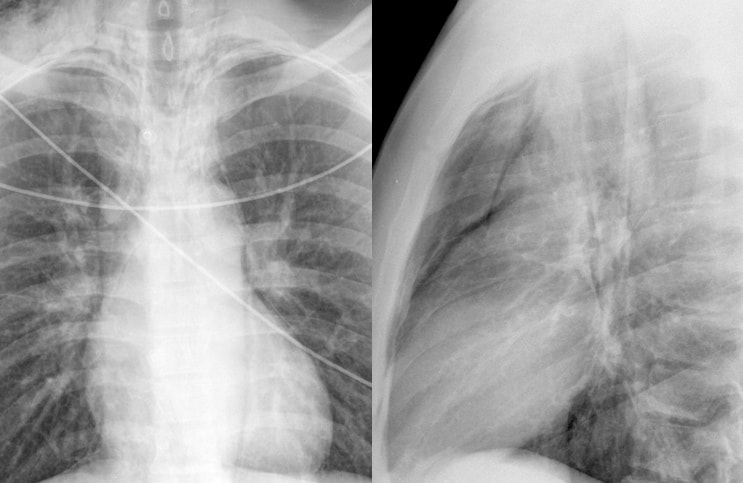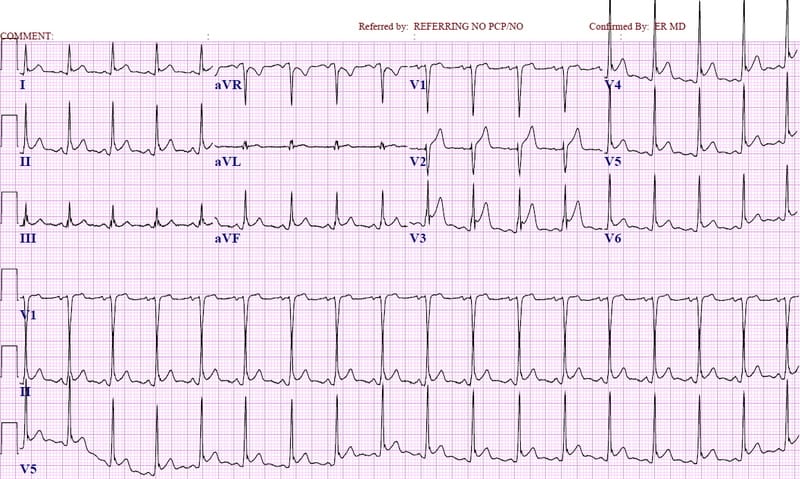Podcast Ep 23: Multiple Sclerosis, SIRS, BRUEs, Pericarditis, & More

We aim above the mark to hit the mark.
-Ralph Waldo Emerson
Welcome back to Episode 23! It was great running into a few listeners at CORD last week and hearing your feedback. This week, we start off with an OB/GYN related pharmacology review before jumping into the new material. Hope you enjoy!

- Cervicitis is treated with ceftriaxone 250 mg IM and azithromycin 1 g PO.
- Bacterial vaginosis is treated with metronidazole twice daily for 7 days.
- Oxytocin or the prostaglandins can both be used in cases of maternal hemorrhage after delivery.
Now onto this week’s podcast
Question 1

A 16-year-old man presents to the ED complaining of 3 days of nasal rhinorrhea, cough, myalgias, and generalized malaise. After a coughing episode yesterday, he developed pleuritic chest pain radiating to the left neck. His vital signs are BP 130/70 mm Hg, HR 76, RR 16, T 36.6°C, and pulse oximetry 98% on room air. You obtain the chest radiograph seen above. Which of the following is the most appropriate next step in management?
A. Discharge home with close follow–up
B. Endoscopy
C. Needle decompression
D. Tube thoracostomy
Question 2

A 17-year-old man with no past medical history presents complaining of constant chest pain for 5 days. He states that he had a cold 2 weeks ago and feels like he never got better. His vitals are T 36.8°C, HR 91, BP 122/75, RR 18, and oxygen saturation 99%. A 12-lead ECG is performed as seen above. What is the appropriate immediate management for this patient?
A. Aspirin 325 mg and activation of the cardiac catheterization lab
B. Azithromycin 500 mg by mouth, followed by 250 mg once a day for 4 days
C. Ibuprofen and prompt follow–up with his primary care doctor
D. Serum d–Dimer test
Question 3
An 84-year-old woman with new-onset altered mental status is sent to the ED from her assisted living facility. According to the facility staff, she has had a productive cough for two days. Her vital signs are blood pressure 90/60 mm Hg, heart rate 92 beats per minute, respiratory rate 25 breaths per minute, temperature 38.3°C, and oxygen saturation 95% on room air. Laboratory results reveal a WBC of 11,000. A chest radiograph shows a right lower lobe infiltrate. Which aspect of this patient’s presentation is consistent with systemic inflammatory response syndrome?
A. Blood pressure
B. Heart rate
C. Infiltrate on chest radiograph
D. White blood cell count
Question 4
A 27-year-old woman presents with a complaint of transient vision loss in her right eye. She states that she has had multiple similar episodes in the past 6 months. She also complains of incomplete bladder emptying, intermittent tremors and intermittent weakness in her left arm. The patient has a family history of multiple sclerosis. Which of the following is the best diagnostic test for the suspected diagnosis?
A. CSF testing for myelin basic protein
B. CT scan of the spine
C. MRI
D. Serum oligoclonal bands
Question 5
Which of the symptoms are most suggestive of Ramsay Hunt syndrome?
A. Bilateral petechiae of the palate
B. Ear pain, facial paralysis, hearing loss
C. Lymphangitis with thrombus formation in the internal jugular vein
D. Photophobia and unilateral thoracic vesicular rash
Question 6
A father brings his 2-week-old newborn to the ED after a gagging episode at home where the infant “turned blue.” The newborn was sleeping in his father’s arms when he started choking, turned blue, and went limp. The father turned the baby over, did 5 back blows, and performed CPR for 5 minutes until the newborn started crying. On exam, the newborn appears sleepy but is easily arousable. Vital signs are HR 160, RR 30, T 37.6°C, and pulse oximetry is 99% on room air. Which of the following is the next best step in management?
A. Admit to hospital for further workup
B. Endotracheal intubation
C. Epinephrine (1:10 000) IV
D. Send home with reassurance

- Pneumomediastinum requires no treatment and patients may be safely discharged.
- Pneumomediastinum often results from ruptured alveoli, commonly after a strenuous Valsalva maneuver. It can also be caused by Boerhaave syndrome.
- Hamman’s sign refers to the crunching sound heard on auscultation of the mediastinum in patients with pneumomediastinum.
- Pericarditis can be seen on EKG with diffuse ST elevations without reciprocal changes along with diffuse PR depressions. It often follows a URI.
- First-line treatment for pericarditis is high-dose ibuprofen. Alternatively, high-dose aspirin or indomethacin may be used. Colchicine may be used in refractory cases or for prophylaxis.
- The SIRS criteria are met if two of the following conditions are met: a heart rate > 90, a temperature > 38° C or < 36° C, a respiratory rate > 20 or a PaCO₂ < 32, or a WBC > 12,000 or < 4,000.
- Multiple sclerosis classically presents with symptoms that are scattered in time. They can range from motor to sensory and can include bladder dysfunction.
- Multiple sclerosis is preferably diagnosed on MRI although CSF oligoclonal bands may be helpful.
- Multiple sclerosis is treated with high-dose methylprednisolone followed by a prednisone taper.
- Ramsey Hunt syndrome is characterized by a triad of unilateral facial paralysis, herpetiform vesicular eruptions, and vestibulocochlear dysfunction. Its caused by a herpes zoster infection and is treated with steroids and antivirals.
- The gram-negative anaerobic bacillus Fusobacterium necrophorum causes Lemierre’s syndrome. Lemierre’s syndrome is a lymphangitis, which can lead to thrombus formation within the internal jugular vein.
- A BRUE is an unexplained frightening episode characterized by apnea, color change, muscle tone change, choking, or gagging, and fear that the child has died. Most children require admission although an etiology will only be found in 50% of cases.
So that wraps up Episode 23. Don’t forget to subscribe so Roshcast episodes are downloaded automatically as they are released. Follow us on Twitter @Roshcast for updates, high-yield images, and pearls in 140 characters or less. We’ll also be at SAEM in two weeks, so feel free to pull us aside and let us know what you think. We are constantly striving to make Roshcast as high yield as possible and welcome all feedback!
Until next time,
Jeff and Nachi





Comments (0)